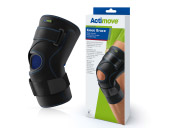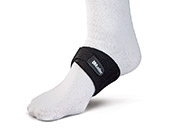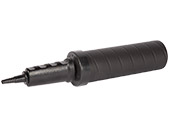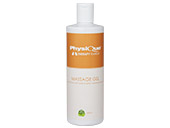Keeping Active with Arthritis
How does arthritis affect exercising and playing sports?
Arthritis can be a very limiting condition which makes it really hard to stay active, it also leaves you with limited options for exercise and staying active. Wearing an arthritis support can help with daily mobility but there's a lot more that you need to know to keep fit.
This is because whether it is rheumatoid arthritis, an auto-immune disease, or osteoarthritis, which is caused by the gradual wear and tear of joints; the result is that people who have arthritis have very vulnerable joints with minimal protection.
This means that some exercises can do a lot of damage to the joint and cause quite a bit of pain so it makes playing your favourite sports almost impossible.
People that develop osteoarthritis typically play a lot of sports or do a lot of exercises so the onset of the condition can cause them to lose confidence in staying active and often avoid sports altogether.
Rheumatoid arthritis can affect people of any age so children with juvenile arthritis tend to end up being wary of playing sports or exercising and it's very easy for them to lose all confidence whatsoever meaning they miss out on a vital part of child development.
This doesn't have to be the case, there are some exercises that should be avoided but there are still some options for people who still want to keep fit.
Exercise can help strengthen the muscles around the joint which takes some weight off the joint and develop and this can in turn help relieve some pain.
There may of course still be a bit of pain when exercising but it is outweighed by the pain from having weaker joints, so it's always worth it to make an effort to stay fit.

What sports should I avoid with Arthritis?
You should generally avoid any high-impact sports like boxing, rugby and other contact sports but less dangerous sports that are physically demanding like football, netball and most other team sports should also be avoided or played with extreme caution.
You should also avoid any repetitive sports because as you can imagine, they'll cause a lot of pain and do damage in terms of wearing away the cartilage around the joints which is not worth the potential muscle strengthening gains.
This shouldn't scare you at all though because some research has indicated that even if you do activities like running and you used to do a lot of running before your osteoarthritis, this doesn't necessarily mean the osteoarthritis will get worse.
This means some exercises and activities might be a case of trial and error but you should follow the advice on avoiding high-impact and repetitive sports when possible.
Wearing a support or brace can help in some cases but it's better to be safe and talk to your doctor about it. An Arthritis pain relief cream could help to alleviate some pain and inflammation after exercise.

What sports and activities can I still enjoy with Arthritis?
Just because you can't play your favourite sports and have to be mindful of any physical activity that you do, this doesn't mean you should lose hope.
There's still a load of activities you can do and some of them you have never really tried or enjoyed so it gives you the opportunity to try something new or find something you didn't know you'd be good at.
Some activities that can help you stay active include:
- Swimming
- Aquatic Exercises / Water Aerobics
- Walking
- Pilates
- Stationary cycling
This is a general list tough so it's still important to do whatever you're comfortable with and just because it's a low-impact exercise doesn't mean you won't be affected by it at all. For example, if you have knee osteoarthritis then stationary cycling may take a toll on your knees or if you've got arthritis in your wrist then some Pilates exercises could prove to be difficult.
Tips for staying active
- Stretch and warm up a bit
- Avoid sugar and red meat because they can increase inflammation
- Exercise as much as possible
- Keep track of your weight
- Find out if your family has a history of arthritis
- Stay mindful of previous injuries and your general anatomy
The most important tip is to exercise as much as possible, keeping active is very important. Even if it's just for 10-15 minutes a day and a few days each week; you'll feel some improvement and be able to take some weight off your joints for when you're doing everyday activities like walking.
Learning a bit more about your family history is also quite important, especially if you are young and have symptoms of arthritis.
This is because although rheumatoid arthritis shows its signs very early, you can also have osteoarthritis at a very young age because early-onset osteoarthritis can happen at any age under 50 years old. General Arthritis management tips can also help you to keep active a lot easier

Best Exercises for Knee and Hip arthritis
Although we've already covered the sports that you should avoid, it's also good to be aware of some exercises that can have a negative impact on your arthritis.
Here are a couple of exercises that are amazing arthritis exercises but please read through the tips if you're intending on doing them because they might agitate your arthritis if you're not careful:
Knee and Hip Osteoarthritis exercises
- Lunges
- Squats
Tips for these Exercises
Squatting is important for both leg and hip strength and can help you maintain your range of motion. If you don't really feel a lot of discomfort then it is generally safe to do your squats.
If you cause a bit of damage then your best option is anti-inflammatory treatments like Cold therapy and pain relief gels.
You may find it easier to squat while leaning against the wall as this will take some weight off your joints and give you some support. 'Deep squatting' is how you can do this, here are some tips for deep squatting:
- Try to straighten your legs as much as possible with your knees directly above your heels as opposed to your toes
- When leaning against a wall, your feet should be at shoulder width, you should be about 45cm (1 and a half rulers) away from the wall, you should use your core muscles as much as possible and your back should always be flat against the wall.
- Try to concentrate your weight on your heels as opposed to your toes and the balls of your feet
Lunging is also a very good exercise but it also comes with risks so if you have just finished some squats and weren't feeling too great towards the end then it's probably best to rest a bit. Here are some tips for deep lunging:
- Use something like a chair as support (just make sure it doesn't have any wheels on it)
- Take a step forward and be mindful of your knee, it should never ass your ankle. The next step is stabilising yourself followed by lifting your back heel until your back heel is in line with your hip.
- Like dep squatting, you should also remember to use your core muscles as much as possible as it keeps you in position and keeps weight off your knee
- The most important thing to remember is to make sure your knee never extends past your ankle

Support your joints
You might think this is the point where we try to sell you a whole bunch of stuff but I can't really stress the importance of supporting your joints enough, it just makes sense.
The key is to make sure you use a support or brace when doing anything physically demanding or repetitive but to not wear it all the time.
If you wear it all the time then some of the progress you made in strengthening muscles could be lost due to increased confidence in the joint.
Wearing an arthritis knee sleeve more casually for activities like walking is a good idea and using a brace for anything where you'll be doing anything risky such as squats and lunges is also a good rule of thumb.
Conclusion - How to keep active with Arthritis
- Keep active as much as possible
- Avoid any unnecessary strain on your joints
- Be aware of your body and what you're doing at all times until you can do everything naturally
- Support your joints
- Be mindful of things like your weight, diet and your anatomy (this includes the role played by your genes and your general history with joint pain)
Sources and references
Knee and hip exercises to avoid - Healthline
















































Did you find this article useful?
Why not share this with a colleague, patient or friend?